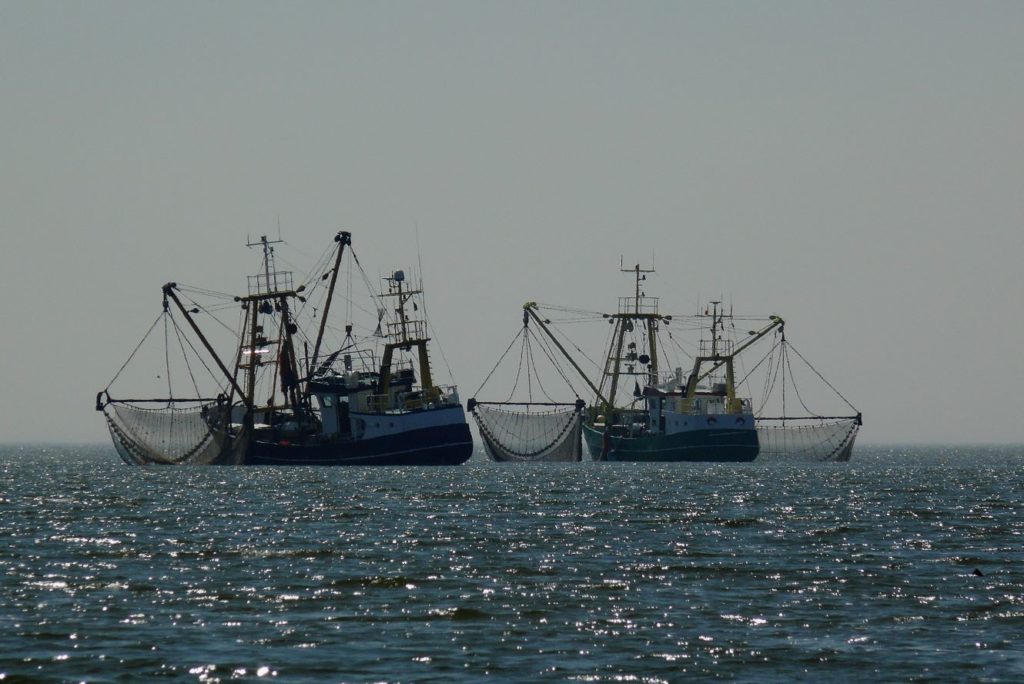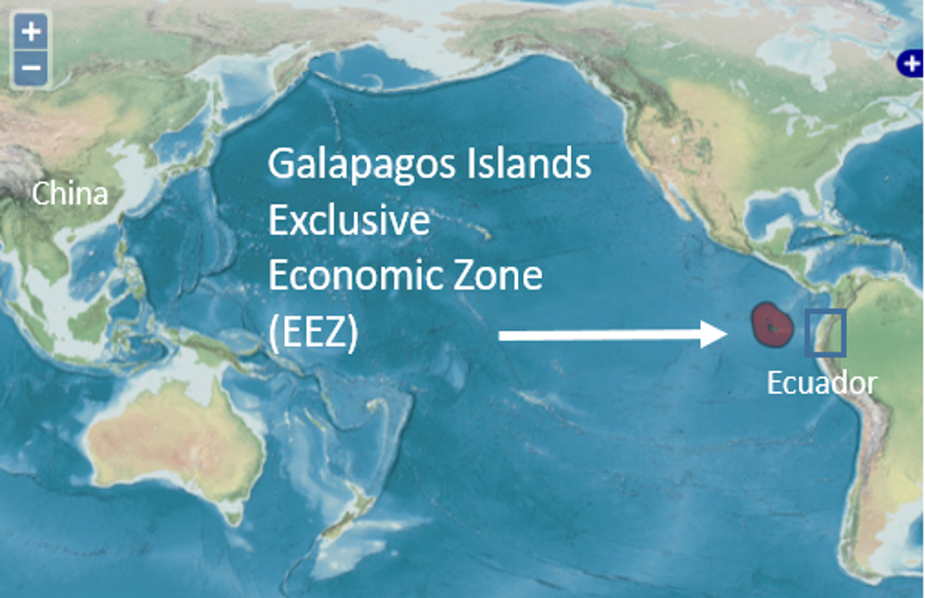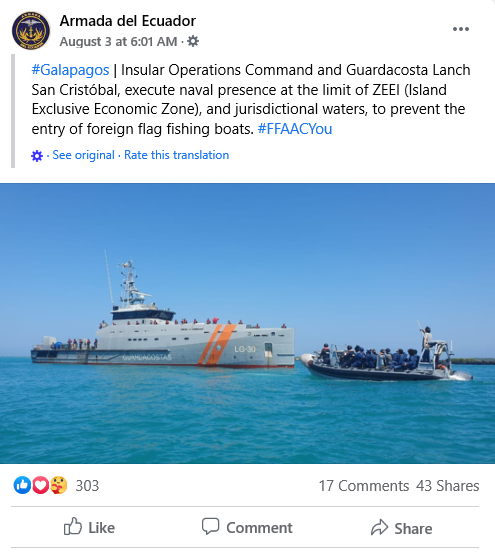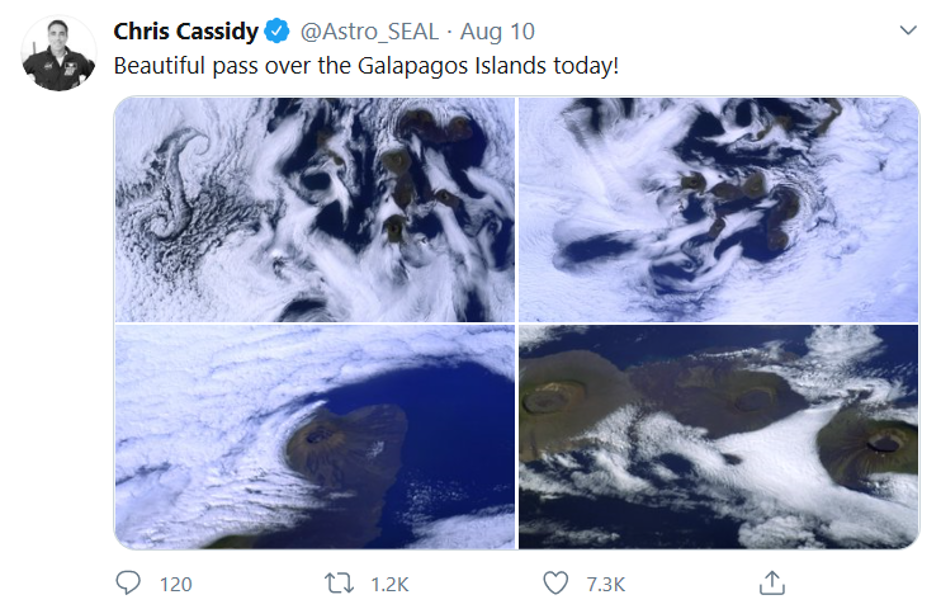The Great Fishing Competition

A Chinese fleet of 340 fishing trawlers just south of the Galapagos Islands is causing outrage from Quito to Washington. For Latin American nations like Ecuador, the presence of the state-subsidized distant-water fishing fleet offers a glimpse into the future of a dangerous combination: China’s increasing demand for resources, extractionist policies, disregard for maritime sovereignty, and irresponsible environmental practices. How can the United States best support regional partners like Ecuador, who despite siginificant economic ties to China are becoming increasingly aggravated at Chinese revisionist behavior off their shores? It is this simple: Follow their lead.
Great-power competition is not a future challenge — an abstract phenomenon to plan and prepare for. It is already taking place today. The People’s Republic of China operates the largest state-subsidized fishing fleet in the world. The questionable practices of the hundreds of Chinese vessels operating off the west coast of South America illustrate the extent to which competition with an ascendant China is already underway in the maritime domain — and far beyond the South China Sea.
In July, Ecuadorian Defense Minister Oswaldo Jarrin announced that the Ecuadorian navy was “on alert” and monitoring a fleet of Chinese fishing trawlers south of the Galapagos economic exclusion zone. The statement sparked concern both domestically and abroad. While Chinese fishing vessels have been active in the area in previous years, the large size of this summer’s fleet made it noteworthy. The response included a statement from Ecuadorian President Lenin Moreno, who vowed to work toward a regional posture to defend the biodiverse region. A statement from Ecuador’s former environment minister, Yolanda Kakabadse, noted that the “fleet’s size and aggressiveness against marine species is a big threat to the balance of species in the Galapagos.” Ecuador’s navy has conducted patrols in the area, including a flyover.
‘Rule-breaking and Willful Environmental Degradation’
On the international front, U.S. Secretary of State Mike Pompeo issued a stern press statement and a tweet admonishing China for its predatory fishing practices in the Galapagos. The statement calls out China for subsidizing “the world’s largest commercial fishing fleet, which routinely violates the sovereign rights and jurisdiction of coastal states, fishes without permission, and overfishes licensing agreements.” Likewise, Pompeo reaffirmed U.S. support for Ecuador and highlighted China’s “willful environmental degradation of the oceans.”
Nongovernmental organizations are also speaking out against the activity. Australia’s Blue Planet Society posted a map depicting the Chinese vessels in the vicinity of the islands with an ominous comment: “We are watching the destruction of the ocean in real time.” The statement likely refers to certain industrial fishing practices, as the boats were observed using stadium-style lighting to attract squid, which can lead to overfishing of the species. Furthermore, many of the vessels are bottom trawlers, which means they use nets that scrape the sea floor to catch fish and invertebrates like shrimp. Bottom trawling is widely regarded as destructive and destabilizing for marine ecosystems. Since the practice is extremely efficient at trapping fish, if unregulated it can lead to overfishing. Other concerns are that bottom trawling is indiscriminate and other animals like whales, dolphins, and even seabirds can get caught in nets and become “bycatch.” Lastly, the dragging of the nets damages the seabed, including delicate species like coral, sea anemone, and urchin. Even the United Nations Educational Scientific and Cultural Organization World Heritage Centre registered its concern regarding the “massive presence of industrial fishing vessels” in the ecologically sensitive Galapagos region, although it refrained from calling out China by name.
The Galapagos Islands: A Natural Wonder
The Galapagos Islands, which belong to Ecuador, are situated about 560 miles off Ecuador’s Pacific coast. The United Nations designated the islands a World Heritage Site in 1978 in recognition of the immense biodiversity and large number of endemic species found on the islands. The surrounding Galapagos Maritime Reserve was similarly added to the list in 2001. Home to the Galapagos tortoise and the Darwin finches that inspired Charles Darwin’s theory of natural selection, the islands occupy a special place in the collective imagination.

The Galapagos Islands off the coast of Ecuador. (Created from base map by author)
The islands partially owe their high levels of biodensity and biodiversity to their location at the confluence of volcanic activity and multiple ocean currents — the South Equatorial Current, the Cromwell Current, the Panama Current, and the Humboldt (or Peruvian) Current. The Humboldt Current brings cold, nutrient-dense waters from the south, making the surrounding equatorial waters of the Galapagos Islands rich in animal life. The area is home to over 3,000 marine species, including critically endangered creatures like the scalloped hammerhead shark. These unique geographical features also make the surrounding waters a productive fishery.
Illegal, Unreported, and Unregulated Fishing
Unfortunately, the rich fishing grounds surrounding the islands also make them vulnerable to the increasingly transnational crime of illegal, unreported, and unregulated fishing. While illegal fishing is not a new phenomenon, the upward trend of commercial fishing fleets from outside the region — mostly Chinese — arriving in regional waters is making it difficult for some Latin American maritime security forces to monitor the activity. In addition to protecting their exclusive economic zones and commercial interests, countries like Ecuador are concerned with protecting the environment and delicate ecosystems from the threats of overfishing and habitat destruction. According to the Trump administration’s May 2020 United States Strategic Approach to the People’s Republic of China, China “ranks first in the world for illegal, unreported, and unregulated fishing in coastal nations’ waters around the world, threatening local economies and harming the marine environment.”
In fact, one of the reasons that the appearance of the large fishing fleet caused so much alarm in Ecuador was the memory of a 2017 incident in which a Chinese fishing trawler, Fu Yuan Yu Leng 999, was interdicted with 6,600 illegally obtained sharks onboard — among them endangered whale sharks and hammerhead sharks.
Surely other Latin American nations are also watching closely. Argentina, Peru, and Chile have had their own confrontations in recent years with Chinese fishing fleets near their exclusive economic zones. In March 2016 in the South Atlantic the Argentinian coast guard caught three Chinese vessels fishing illegally in Argentina’s waters. Coast guard ships and helicopters intervened, but the Chinese vessels ignored warnings. While two vessels fled, the third, Lu Yan Yuan Yu 010, was shot at by the Argentinian patrol forces — and then reportedly tried to ram the Argentinian vessel before it sank. In 2018, Peruvian authorities stopped the Chinese vessel Runda 608 for fishing without authorization in Peruvian waters. Similarly, Chilean forces boarded and searched a Chinese vessel in their exclusive economic zone in 2015 — although no illegal cargo was found aboard.
In recognition of the fact that illegal, unreported, and unregulated fishing is of regional concern, the commander of Ecuador’s navy, Rear Adm. Darwin Jarrin, has stated his intention to cooperate with Colombia and Peru on both information sharing and response efforts. Ecuadorian Foreign Minister Luis Gallegos signaled a commitment to working toward a regional approach by acknowledging the necessity of “bilateral agreements with other countries with regards to illegal fishing, to monitor every ship that’s in the South Pacific.”

A Facebook post from the Ecuadorian navy on Aug. 3, as the largest Chinese fishing fleet in several years was a few miles outside Ecuadorian waters. (Photo by the author)
The threat from encroaching Chinese fishing fleets is only projected to grow as climate change and the rising global population mean that demand for fish will continue to increase. Currently the top consumer of seafood globally, China’s fish consumption is projected to grow at six percent annually. China is already regularly clashing with neighbors in the South China Sea over fishing practices, including a recent flare-up with Japan around the Senkaku/Diaoyu Islands. In addition to being an affront to national sovereignty, extra-regional illegal, unreported, and unregulated fishing denies regional economies access to valuable natural resources — in this case, marine protein — for both domestic and international markets. For a country already indebted to China to the tune of $5.3 billion, the menace of fishing illegally off Ecuador’s coast likely adds insult to injury.
Sino-Ecuadorian Relations: Partnership or “Debt-Trap Diplomacy?”
Ecuador has historical ties to China, which were strengthened in 2007 after the election of President Rafael Correa as part of the “pink tide” — a wave of transitions to left-leaning, anti-United States administrations in the region. A small example of this kind of sentiment can be seen in the fact that, in a jab to the United States, WikiLeaks founder Julian Assange was offered diplomatic refuge at the Ecuadorian embassy in London in 2012, to avoid extradition.
During Correa’s presidency, the country took billions of dollars in loans from China — in exchange, PetroEcuador, Ecuador’s state oil company, supplied China with crude oil. Some, like Pompeo, have criticized such economic agreements as “debt-trap diplomacy” — a predatory tactic where a creditor nation intentionally allows a debtor to overextend and then demands excessive economic or diplomatic concessions (e.g., fishing rights). Consider the case of Sri Lanka. Unable to continue servicing debts to China, the country completed a debt/equity swap and handed over the strategic port facility at Hambantota to China Merchants Port Holdings.
In 2017, Ecuador elected Moreno, who served as Correa’s vice president from 2007 to 2013. The two have since had a public falling-out, and Moreno has reversed some of Correa’s main legislative victories. Correa, living in exile in his wife’s native Belgium, was found guilty in April of bribery and corruption charges in Ecuador. He was also charged in Ecuador in 2018 for his role in a kidnapping attempt of a political rival.
New Era of U.S.-Ecuadorian Cooperation
With the election of Moreno in 2017, U.S.-Ecuadorian relations are warming, as evidenced by Ecuador granting refueling permissions for U.S. counter-drug surveillance planes in the Galapagos. Also, the Ecuadorian navy participated in UNITAS 2019, a United States-led multinational maritime exercise. Coincidentally (or not), in 2019 Assange’s Ecuadorian citizenship was rescinded, and he was removed from the country’s embassy in London.
Adm. Craig Faller, Commander of United States Southern Command, reaffirmed U.S. commitment to the region in his 2018 Senate nomination hearing: “My plain and simple message to our friends in the region is ‘the United States is a reliable and trustworthy security partner’ … Our commitment is unwavering.”

U.S. Navy Adm. Craig Faller meets with Ecuadorian Minister of Defense Gen. Oswaldo Jarrin in 2019. (Photo courtesy U.S. Embassy Ecuador)
Despite warming diplomatic and military relations with the United States, Ecuador is still economically enmeshed with China. In addition to its existing debt, the Moreno administration is currently negotiating an additional $2 billion loan deal. However, standing with Ecuador against Chinese illegal fishing represents an excellent opportunity for the United States to reinforce a new era of partnership and cooperation with Ecuador. Doing so is in line with a mandate from the 2018 National Defense Strategy, which points out that revisionist states “are particularly adept at exploiting their economic relationships with many of our security partners. We will support U.S. interagency approaches and work by, with, and through our allies and partners to secure our interests and counteract this coercion.”
Future Threat of Chinese Navy Presence in the Region
While this obscure diplomatic event seems relatively benign on the competition continuum, one can extrapolate to envision what future escalation could look like in the western hemisphere if this type of activity goes unchecked. In a piece for the Center for International Maritime Security, W. Alejandro Sanchez observes, “Demographic growth, the eternal quest for profit, and depleting maritime life in other bodies of water mean that extra-regional fleets will travel great distances for new sources of fish.”
As China looks to secure resources — including food — for its 1.43 billion citizens, it could resort to escalatory tactics like embarking security crews to intimidate regional maritime patrol forces looking to protect their waters, or even deploying naval combatants to escort the fleets. The People’s Armed Forces Maritime Militia has been deployed in this role regularly in the South China Sea with much success, to the chagrin of regional neighbors. In an alarming incident in 2016, a Chinese fishing vessel rammed and sank a South Korean coast guard vessel in an altercation in the Yellow Sea.
U.S. Naval Academy Professor Claude Berube articulates the urgency of the situation in his piece “Stand Up a Joint Interagency Task Force to Fight Illegal Fishing,” pointing out that
“Chinese fishing vessels are plying global waters for their own interests, but tomorrow, their white hulls will follow to protect these interests. And then, given the quickly growing size of the Chinese Navy, gray hulls will eventually ensure that fishing fleets go virtually unimpeded by any nation.”
The militarization of the maritime commons in a region like Latin America, which has largely avoided a turn to interstate conflict, would be unfortunate.
As part of a great-power competition strategy, it remains important for the United States to focus on maintaining military advantage to dominate in a “high-end” fight. However, it is becoming increasingly clear that countering Chinese “sharp power” consistently will likely be the best predictor of long-term success against the revisionist power. It is in the consistency of U.S. response to delicate incidents like the Chinese state-subsidized fishing fleet near the Galapagos Islands that the United States can demonstrate its commitment to international maritime norms.
In this case, the United States, through Pompeo’s pointed press statement and tweet, used diplomatic tactics to counter China’s attempts at redefining existing maritime norms. The statement simultaneously supported a regional partner, condemned China’s extractive economic practices and disregard for environmental stewardship, and reaffirmed a commitment to a rules-based international order. In a more subtle move, a well-timed tweet from U.S. astronaut Chris Cassidy showing a picturesque image of the Galapagos Islands from space amid the controversy is a good example of how the United States can compete with China across domains — in this case, in the information space.

U.S. Navy SEAL and Astronaut Chris Cassidy tweets a photo of the Galapagos Islands Aug. 10. (Screenshot by the author)
Recommendations for Regional Engagement
Given relatively small defense budgets in Latin America, some countries might welcome the invited presence of U.S. assets to help maintain maritime domain awareness, at least in the short term. These capabilities could include assets from the U.S. Naval Forces Southern Command and the U.S. Fourth Fleet, such as maritime patrol and reconnaissance aircraft, unmanned aerial systems at sea, and surface ships. In order to build proficiency in specialty skills — from operating unmanned aerial systems to outboard motor maintenance — host nations can request tailored mobile training teams from entities like the U.S. Special Operations Command’s Naval Small Craft and Instructional Training School. Intelligence sharing would also be an essential part of any solution. The topic could also be explored in regular security cooperation events like Southern Partnership Station and maritime exercises.
In developing a broader approach for partnering with Latin American states who might want to cooperate to counter Chinese revisionist behavior in the maritime commons, the United States should carefully consider attitudes regarding both intervention and conflict in the region.
Acknowledging Regional Attitudes toward U.S. Intervention
First, decision-makers should keep in mind the regional collective memory toward previous U.S. involvement in the region. Prior U.S. military and intelligence activities loom large in places like Chile, Dominican Republic, Haiti, Nicaragua, and Panama (among others). It is not uncommon in the cities of Latin America to see graffiti with some version of “Go home, Yankee imperialists.” Taking those realities and attitudes into account, it follows that a practical approach would ensure that Latin American partners feel like they are in the driver’s seat in any combined effort. This will take patience for the U.S. military establishment but will pay dividends in the long run. If the choices are to lead, follow, or get out of the way, the United States should do its best to follow and allow the affected countries, like Ecuador, to set the pace for cooperative efforts.
Do No Harm
Second, the United States should recognize the abiding, transnational inclination within Latin America toward cooperation and avoiding interstate conflict. There have certainly been instances of interstate armed conflict in the region including the Cenepa War (fought by Ecuador and Peru, 1995), the Football War (fought by El Salvador and Honduras, 1969), the Chaco War (fought by Bolivia and Paraguay, 1932-35), the Falklands or Malvinas War (fought by Argentina and the United Kingdom, 1982), and the War of the Pacific (fought by Chile and a Bolivia-Peru alliance, 1879-84). But the overwhelming trend demonstrates a relative lack of interstate conflict (when compared to parts of Africa or the Middle East, for example). This commitment to cooperation can be observed in that neighboring states consciously modulate increases in defense spending to foster trust and not alarm one another. The United States should be mindful to not upset this balance when considering programs like foreign military sales.
This geopolitical trend can partly be explained by similarities in contemporary histories, which largely center on keeping foreign powers at bay and may have paved the way for the high levels of regional cooperation. The Andean nations (Bolivia, Colombia, Ecuador, and Peru), for example, all gained independence from Spain between 1810 (Colombia) and 1825 (Bolivia). Additionally, some nations have pursued regional cooperation efforts largely in order to balance perceived threats from extra-regional powers, namely the United States. The Bolivarian Alliance for the Peoples of Our America, initiated by Cuba and Venezuela in 2004, is an example of regional cooperation to counter U.S. influence (of note, Ecuador exited the alliance in 2018).
Relative ethnic, linguistic, and religious homogeneity in many parts of South America (at least among elites) serves to facilitate regional cooperation. Unlike in Afghanistan, Iraq, and Syria (where the Department of Defense has largely focused over the past two decades), where sectarianism and tribalism are major factors, Latin America, although diverse, does not have the same challenge of overcoming divisions rooted in centuries of factional violence. That is not to say that the region is without challenges to integration, but any U.S. policies in Latin America should strive to continue fostering this tendency toward cooperation, as a strong regional posture will be required in countering the Chinese agenda in Latin America.
Acknowledging the relative interstate peace in Latin America is not to say that the region is devoid of security challenges or latent tensions. Venezuela, mired in political and economic turmoil, is facing the Western Hemisphere’s largest ever humanitarian and migrant crisis. Colombia still grapples with significant internal challenges from armed groups in the aftermath of civil conflict and insurgency. Additionally, Latin American cities occupy the top ten spots on lists of the world’s most dangerous cities. This statistic is particularly staggering because Latin America is home to only eight percent of the global population. Much of the violence centers on transnational organized crime and gang activity associated with illicit trafficking in humans, drugs, and weapons. Reporting also suggests that Latin American transnational criminal organizations have collaborated with terror groups like Hizballah, which has a longstanding presence in the tri-border area between Brazil, Argentina, and Paraguay.
Tailored Approach
Latin America faces unique challenges that will require tailored approaches. In their piece entitled “Navigating the future — and understanding the troubled past — of great-power competition in Latin America,” Ryan Kertis and Chris Bernotavicius advocate for a unique, regionally specific approach. They astutely point out that “rule of law, social equality, and a strong civil society are more vital to any strategy to compete with foreign influence than the scale of military aid. During the Cold War, strong social forces, compounded by weak economic structures, created the conditions for increased communist influence. No amount of military aid was going to change those facts. The same may be true for this new era of competition.” Therefore, viewing the situation as an opportunity to aid allies in building capacity, rather than to counter a revisionist adversary, should remain at the forefront. This approach is not only likely to yield better outcomes, but it also demonstrates U.S. commitment to being a responsible power and provides a foil against Chinese malign activity in the region.
Policymakers should, therefore, be mindful of the potential for misconceptions surrounding U.S. involvement and be deliberate in their messaging to both allies and partners as well as international audiences. Any effort should be a Latin American effort, by Latin Americans for Latin America — with security cooperation support from the United States as and when requested. To that end, the United States should continually encourage bilateral and regional solutions, leveraging organizations like the Organization of American States.
With the apparent failure of the “pink tide,” as Latin American nations have largely eschewed leftist candidates at the ballot box, the United States should capitalize on this momentum. In events like the industrial fishing fleet near the Galapagos, the international community is beginning to see the perils of coercive Chinese influence and revisionism first hand, from breaches of sovereignty to disregard for overfishing in protected ecosystems. Calling attention to the problem — in the Ecuadorian and international media — also represents an excellent first step. It did not hurt that the Chinese aggression happened to be in the vicinity of a treasured ecological reserve, which helped propel this story into media outlets it might not have otherwise reached.
True Colors
U.S. defense officials and policymakers alike often lament the challenge of competing with an authoritarian regime like the Chinese Communist Party, whose policies and operations are not subject to the same moral or ethical constraints as the United States. While an authoritarian approach can sometimes work out favorably for these regimes, sometimes it does not. This is one of those cases. Sending a fishing fleet 9,000 miles across an ocean to fish only miles outside of your “partner’s” treasured maritime ecological reserve sends a message — one that both Ecuador and the international community received loud and clear — that China’s insatiable appetite for natural resources and disregard for international norms are a dangerous combination.
In this sense, the United States can hope to outmaneuver against China — or let China outmaneuver against itself — without ever firing a shot.
Lisa McKinnon Munde is a graduate of the United States Naval Academy and received a master of arts in Latin American Studies from Stanford University. She served six years as a naval intelligence officer, including assignments at the U.S. Embassy in Madrid, VFA-97 and USS Nimitz Carrier Strike Group, and Naval Special Warfare Group ONE. She is a consultant for Naval Special Warfare Command on matters relating to doctrine, plans, and strategy. Lisa is interested in the intersection of Latin America, military strategy, and current events.
Connect via LinkedIn: https://www.linkedin.com/in/lisamunde/
Image: Maxpixel

